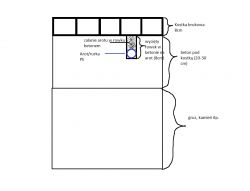Hello. I need to run a 5x4mm? cable to the garage, unfortunately the only way is through the paving stones, under which there is a lot of concrete, and under the concrete there is stone and rubble. Standard disassembly of the cube, digging a ditch in this case will be expensive, laborious with a lot of mess, and in the end the cube will sit down under the pressure of trucks that sometimes have to drive in (some say that if it's done right, nothing will sit down, but once I had to disassemble a piece of paving stone, dig a hole and despite a decent compaction of the material, the paving stone sat in this place), so it's 100% out and I'll fix the cable by air sooner.
But, I came up with the idea to pull out a row of cubes, cut a groove about 10 cm deep, put arot or PE pipe in it, and then pour concrete. I'm just wondering if water will collect there, which could damage the cable in the winter. Or maybe lay the ground cable itself, without additional protection? But then I would be afraid that it might rub against the concrete. I know that this is not professional workmanship and you should dig a pit, lay the ground wire at a depth of 90 cm, and cover it with sand, but I do it at home, I would not dare to do such a combination at someone else's. What do you think? Regards.
I've attached a picture that shows a bit of my vision.

But, I came up with the idea to pull out a row of cubes, cut a groove about 10 cm deep, put arot or PE pipe in it, and then pour concrete. I'm just wondering if water will collect there, which could damage the cable in the winter. Or maybe lay the ground cable itself, without additional protection? But then I would be afraid that it might rub against the concrete. I know that this is not professional workmanship and you should dig a pit, lay the ground wire at a depth of 90 cm, and cover it with sand, but I do it at home, I would not dare to do such a combination at someone else's. What do you think? Regards.
I've attached a picture that shows a bit of my vision.



